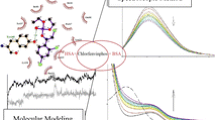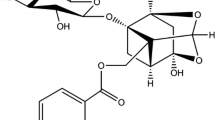Abstract
Polychlorinated biphenyls (PCBs) are potentially hazardous to the environment because of their chemical stability and biological toxicity. In this study, we identified the binding mode of a representative PCB180 to human serum albumin (HSA) using fluorescence and molecular dynamics (MD) simulation methods. PCB180 bound exactly at subdomain IIIA of HSA based on the fluorescence study along with site marker displacement experiments. PCB180 also induced conformational changes that were governed mainly by hydrophobic forces. MD studies and free energy calculations also made important contributions to the understanding of the effects of an HSA-PCB180 system on conformational changes. The simulations on binding behavior proved that PCB180 was located only in subdomain IIIA. Hydrophobic interactions dominated the mode of binding behavior. The results obtained using the two methods correlated well with each other. Our findings provide a framework for elucidating the mechanisms of PCB180-HSA binding, and may also help in further research on the transportation, distribution, and toxicity effects of PCBs when introduced into human blood serum.





Similar content being viewed by others
References
Kavlock RJ, Daston GP, DeRosa C, Fenner-Crisp P, Gray LE, Kaattari S, Lucier G, Luster M, Mac MJ, Maczka C, Miller R, Moore J, Rolland R, Scott G, Sheehan DM, Sinks T, Tilson HA (1996) Research needs for the risk assessment of health and environmental effects of endocrine disruptors: a report of the U.S. EPA-sponsored workshop. Environ Health Perspect 104:715–740
Wehrmeier A, Lenoir D, Schramm LW, Zimmermann R, Hahn K, Henkelmann B, Kettup A (1998) Patterns of isomers of chlorinated dibenzo-p-dioxins as tool for elucidation of thermal formation mechanisms. Chemosphere 36:2775–2801
Giesy JP, Kannan K (1998) Dioxin-like and Non-dioxin-like toxic effects of polychlorinated biphenyls (PCBs): implications for risk assessment. Crit Rev Toxicol 28:511–569
Sanchez E, Fernandez SM, Lopez-Aparicio P, Recio MN, Perez-Albarsanz MA (2000) Selective fatty acid release from intracellular phospholipids caused by PCBs in rat renal tubular cell cultures. Chem Biol Interact 125:117–131
Howard AS, Fitzpatrick R, Pessah I, Kostyniak P, Lein PJ (2003) Polychlorinated biphenyls induce caspase-dependent cell death in cultured embryonic rat hippocampal but not cortical neurons via activation of the ryanodine receptor. Toxicol Appl Pharmacol 190:72–86
Kester MH, Bulduk S, Tibboel D, Meinl W, Glatt H, Falany CN, Coughtrie MW, Bergman A, Safe SH, Kuiper GG, Schuur AG, Brouwer A, Visser TJ (2000) Potent inhibition of estrogen sulfotransferase by hydroxylated PCB metabolites: a novel pathway explaining the estrogenic activity of PCBs. Endocrinology 141:1897–1900
Inglefield JR, Mundy WR, Meacham CA, Shafer TJ (2002) Identification of calcium-dependent and -independent signaling pathways involved in polychlorinated biphenyl-induced cyclic AMP-responsive element-binding protein phosphorylation in developing cortical neurons. Neuroscience 115:559–573
Zolese G, Falcioni G, Bertoli E, Galeazzi R, Wozniak M, Wypych Z, Gratton E, Ambrosini A (2000) Steady-state and time resolved fluorescence of albumins interacting with N-oleylethanolamine, a component of the endogenous N-acylethanolamines. Proteins 40:39–48
Petitpas I, Grnne T, Bhattacharya AA, Curry S (2001) Crystal structures of human serum albumin complexed with monounsaturated and polyunsaturated fatty acids. J Mol Biol 314:955–960
Ghuman J, Zunszain PA, Petitpas I, Bhattacharya AA, Otagiri M, Curry S (2005) Structural basis of the drug-binding specificity of human serum albumin. J Mol Biol 353:38–52
Curry S, Mandelkow H, Brick P, Franks N (1998) Crystal structure of human serum albumin complexed with monounsaturated and polyunsaturated fatty acid. Nat Struct Biol 5:827–835
Fehske KJ, Mullar WE, Wollart U (1981) The location of drug binding sites in human serum albumin. Biochem Pharmacol 30:687–692
Khan SN, Islam B, Yennamalli R, Sultan A, Subbarao N, Khan AU (2008) Interaction of mitoxantrone with human serum albumin: Spectroscopic and molecular modeling studies. Eur J Pharm Sci 35:371–382
Deeb O, Rosales-Hernández MC, Gómez-Castro C, Garduño-Juárez R, Correa-Basurto J (2010) Exploration of human serum albumin binding sites by docking and molecular dynamics flexible ligand-protein interactions. Biopolymers 93:161–170
Herve F, Urien S, Albengres E, Duche JC, Tillement JP (1994) Drug binding in plasma: a summary of recent trends in the study of drug and hormone binding. Clin Pharmacokinet 26:44–58
Houde M, Martin JW, Letcher RJ, Solomon KR, Muir DCG (2006) Biological monitoring of polyfluoroalkyl compounds: a critical review. Environ Sci Technol 40:3463–3473
Lejon S, Cramer JF, Nordberg PA (2008) Structural basis for the binding of naproxen to human serum albumin in the presence of fatty acids and the ga module. Acta Crystallogr F 64:64–69
Patel S, Datta A (2007) Steady state and time-resolved fluorescence investigation of the specific binding of Two chlorin derivatives with human serum albumin. J Phys Chem B 111:10557–10562
Purcell M, Neault JF, Malonga H, Arakawa H, Carpentier R, Tajmir-Riahi HA (2001) Interactions of atrazine and 2,4-D with human serum albumin studied by gel and capillary electrophoresis and FTIR spectroscopy. Biochim Biophys Acta 1548:129–138
Saquib Q, Al-Khedhairy AA, Siddiqui MA, Roy AS, Dasgupta S, Musarrat J (2011) Preferential binding of insecticide phorate with sub-domain IIA of human serum albumin induces protein damage and its toxicological significance. Food Chem Toxicol 49:1787–1795
Xie XY, Wang XR, Xu XM, Sun HJ, Chen XG (2010) Investigation of the interaction between endocrine disruptor bisphenol A and human serum albumin. Chemosphere 80:1075–1080
Fujiwara S, Amisaki T (2008) Identification of high affinity fatty acid binding sites on human serum albumin by MM-PBSA method. Biophys J 94:95–103
Quevedo MA, Ribone SR, Moroni GN, Brinon MC (2008) Binding to human serum albumin of zidovudine (AZT) and novel AZT derivatives. Bioorg Med Chem 16:2779–2790
Sudhamalla B, Gokara M, Ahalawat N, Amooru DG, Subramanyam R (2010) Molecular dynamics simulation and binding studies of β-sitosterol with human serum albumin and its biological relevance. J Phys Chem B 114:9054–9062
Safe SH (1994) Polychlorinated-biphenyls (PCBs)-environmental-impact, biochemical and toxic responses, and implications for risk assessment. Crit Rev Toxicol 24:87–149
Rahman MH, Maruyama T, Okada T, Yamasaki K, Otagiri M (1993) Study of interaction of carprofen and its enantiomers with human serum albumin-I. Stereoselective site-to-site displacement of carprofen by ibuprofen. Biochem Pharmacol 46:1721–1731
Petitpas I, Bhattacharya AA, Twine S, East M, Curry S (2001) Crystal structure analysis of warfarin binding to human serum albumin: anatomy of drug site I. J Biol Chem 276:22804–22809
Anderson AC, O’Neil RH, Surti TS, Stroud RM (2001) Approaches to solving the rigid receptor problem by identifying a minimal set of flexible residues during ligand docking. Chem Biol 8:445–457
Sherman W, Day T, Jacobson MP, Friesner RA, Farid R (2006) Novel procedure for modeling ligand/receptor induced fit effects. J Med Chem 49:534–553
Morris GM, Goodsell DS, Halliday RS, Huey R, Hart WE, Belew RK, Olson AJ (1998) Automated docking using a Lamarckian genetic algorithm and an empirical binding free energy function. J Comput Chem 19:1639–1662
Case DA, Darden TA, Cheatham TE, III Simmerling CL, Wang J, Duke RE, Luo R, Walker RC, Zhang W, Merz KM, Roberts B, Wang B, Hayik S, Roitberg A, Seabra G, Kolossvai I, Wong KF, Paesani F, Vanicek J, Liu J, Wu X, Brozell SR, Steinbrecher T, Gohlke H, Cai Q, Ye X, Wang J, Hsieh MJ, Cui G, Roe DR, Mathews DH, Seetin MG, Sagui C, Babin V, Luchko T, Gusarov S, Kovalenko A, Kollman PA (2010) AMBER 11. http://ambermd.org/
Wang J, Wolf RM, Caldwell JW, Kollman PA, Case DA (2004) Development and testing of a general AMBER force field. J Comput Chem 25:1157–1174
Kollman PA, Massova I, Reyes C, Kuhn B, Huo SH, Chong L, Lee M, Lee T, Duan Y, Wang W, Donini O, Cieplak P, Srinivasan J, Case DA, Cheatham TE (2000) Calculating structures and free energies of complex molecules: combining molecular mechanics and continuum models. Acc Chem Res 33:889–897
Ross PD, Subramanian S (1981) Thermodynamics of protein association reactions: forces contributing to stability. Biochemistry 20:3096–3102
Gao H, Lei L, Liu J, Qin K, Chen X, Hu Z (2004) The study on the interaction between human serum albumin and a new reagent with antitumour activity by spectrophotometric methods. J Photochem Photobiol A 167:213–221
Pandey RK, Constantine S, Tsuchida T, Zheng G, Medforth CJ, Aoudia M, Kozyrev AN, Rodgers MAJ, Kato H, Smith KM, Dougherty TJ (1997) Synthesis photophysical properties in vivo photosensitizing efficacy and human serum albumin binding properties of some novel bacteriochlorins. J Med Chem 40:2770–2779
Consuelo Jiménez M, Miranda MA, Vayá I (2005) Triplet excited states as chiral reporters for the binding of drugs to transport proteins. J Am Chem Soc 127:10134–10135
Sułkowska A, Maciążek-Jurczyk M, Bojko B, Równicka J, Zubik-Skupień I, Temba E, Pentak D, Sułkowski WW (2008) Competitive binding of phenylbutazone and colchicines to serum albumin in multidrug therapy: a spectroscopic study. J Mol Struct 881:97–106
Eliard PH, Rousseau GG (1984) Biochem J 18:395
Acknowledgments
This work was supported financially by National Natural Science Foundation of China (NO. 31000017) (NO. 21207056), the Natural Foundation of Gansu Province (1104WCGA187) and Key Laboratory of Chemistry and Quality for Traditional Chinese Medicines of the College of Gansu Province, Gansu College of Traditional Chinese Medicine (Zzy-2011-03).
Author information
Authors and Affiliations
Corresponding author
Additional information
Senbiao Fang and Huanhuan Li contributed equally to this work.
Rights and permissions
About this article
Cite this article
Fang, S., Li, H., Liu, T. et al. Molecular interaction of PCB180 to human serum albumin: insights from spectroscopic and molecular modelling studies. J Mol Model 20, 2098 (2014). https://doi.org/10.1007/s00894-014-2098-7
Received:
Accepted:
Published:
DOI: https://doi.org/10.1007/s00894-014-2098-7




